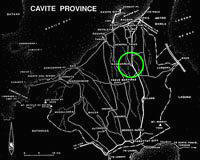
![]()
Spanish
Colonization
American Period
Japanese Occupation
Timeline
Officials
![]()
Geography &
Climate
Map & Places
The People & Celebrations
Commerce & Industry
Economic Growth
Transportation &
Communication
Support Facilities
Health Services
Sports & Recreation
Schools & Universities
Government Officials
Cable Channel
Radio Station
THE HISTORY OF DASMARIÑAS: AMERICAN PERIOD
With the signing of the Treaty of Paris on December 10, 1898 (ratified Washington on February 6, 1899), the Philippines was ceded to America by Spain. The Americans came, and like Ceasar, they saw and conquered.
The American regime brought to Dasmariñas, as it did to other parts of the country, several fundamental changes in the system of government, in language, an in educational system.
The new invaders were very much unlike their predecessor, they generally pursued their interest and conquest though a policy of attraction. Call it an unmitigated form of brainwashing, the fact remains that the Americans did their colonization job thoroughly and well - so thoroughly and well that 44 years after the grant of Philippine independence, the country is still as dependent as ever on America for their ultimate survival.
The Americans did not really want to help the Philippines did not really want to help the Philippines. She wanted to colonize her. As President McKinley said, "The Philippines is ours as much as Louisiana by purchase, or Texas or Alaska.
In the month of February, 1899, the Philippine-American War began. General Henry Ware Lawton's brigade operated in the south of Manila, including the province of Cavite, in the middle of June 1899. The Americans could not land directly at Bacoor because Zapote river was defended by the Filipino revolutionists who built trnches forming three sides of an angle. The Filipinos who displayed a rare intelligence in the construction of their defenses were hardly visible. The American's 14th Infantry Batallion swam across the Zapote river, and under cover of military artillery, charged against the FIlipinos, who then retreated to the woods.
Moving southward, the Americans encountered more Filipino revolutionists in the town of Bacoor, Imus and Perez-Dasmariñas, a batallion of infantry narrowly escaped annihilation. News had been brought to the American camp that the Filipino soldiers had evacuated the town and that the native mayor was disposed to surrender it formally tothe Americans.
The batallion thus went there to take possesion, but before reaching the place, the Filipino revolutionists closed in on all sides, and a heavy firefight went on for hours. The Americans were saved from destruction by a desperate bayonet charge when they were rescued by General Weaton's brigade.
Placido Campos, who sided with General Emilio Aguinaldo since the beginning of the Filipino-American war in 1899, was captured together with his nephew Guillermo Campos. They were imprisoned at the Provost Political Prison on Postigo St., Intramuros, Manila where they were kept for six months.
The Americans established the Military Government in 1900. By an order of the Colonel of the American Batallion stationed in Perez-Dasmariñas, the residents of the town nominated a president and a vice-president. Elected through the raising of hands were Francisco Barzaga, president and Conrado Malihan as vice-president. They served their office until the civil government was established by the Americans in 1901.
On January 31, 1901, in accordance with President McKinley's instructions that the Filipinos be allowed to manage their own municipal governments, the Second Philippine Commission enacted the Municipal Code Act Number 82, placing each municipal government under the following officials: the municipal president, the vice-president, and the municipal council, who were elected by qualified voters every two years. In line with this, Placido Campos was again elected as the head of the municipality of Perez-Dasmariñas in October 1901. Francisco Barzaga then became the Treasurer of Dasmariñas. The two were re-elected in 1903.
In 1903, the American government made the first census in the Philippines. The treasurer, Francisco Barzaga and the secretary, Esteban Quique, made census enumerators for Perez-Dasmariñas under the leadership of Placido Campos. When the census was finished, the total population of the town was only 3,500. Before the revolution of 1898, the population was 12,000. There were 20 Cabezas de Barangay and each of which had 200 persons with ages ranging from 18 to 59 years, men and women, the number of children which estimated to be more or less 6,000 will give us a figure of 12,000. Comparing the population prior to the revolution with that of 1948, we can definitely say that there has been a decrease in the population of Perez-Dasmariñas. The 1948 census accounted to only 9,700 while that of the pre-revolutionary period totaled 12,000.
From 1905 to 1916, the law which was passed in 1901 took effect. It combined the municipalities of Imus, Perez-Dasmariñas and Bacoor into one, with the seat of government located at Imus. Consequently, on January 5, 1905, Perez-Dasmariñas became a part of Imus. The reason for this was to punish the insurrectos for not surrendering. Besides, the inability of the people to work outside from fear of being suspected by the Constabulary greatly decrease the income of the municipalities to the detriment of the employees and the policemen.
In 1917, under Governor General Francis Burton Harrison (1913-1921), Perez-Dasmariñas was again declared a separate municipality. The provincial governor of Cavite, Antero S. Soriano, convened the local leaders, including Placido Campos, Francisco Barzaga, and Felipe Tirona. Together, they agreed to delete the word "Perez" and retain "Dasmariñas" as the new name of the town. For the second time, Placido Campos headed the rechristened town of Dasmariñas.
The old municipio or casa tribunal during the Spanish period was destroyed at the height of the revolution. It got burned when the rebels used it as hideout when the Spaniards attacked the town. It was located on the southern part of the town, about 500 meters away from the church.
|
Best viewed with Microsoft Internet Explorer 5 and up at 800x600 resolution |
|
Copyright © 2003, DASMA ONLINE. All rights reserved. |